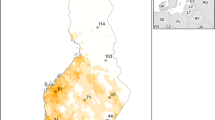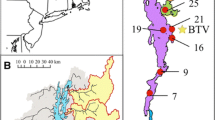Abstract
Nitrogen mass balances for seven unproductive lakes and 20 forested catchments in central Ontario were measured between 1977 and 1989. Average annual lake denitrification rates calculated with the N/P ratio method were strongly correlated with summer anoxic factor (extent of surficial sediment anoxia) whereas denitrification rates calculated with a210Pb sediment N accumulation method were poorly correlated with the anoxic factor suggesting that the N/P method is superior. Substantial denitrification occurred in all lakes — an average of 36% of TN inputs or 75% of the net gain. On a regional area-weighted basis, 67% of bulk atmospheric TN deposition was stored or denitrified terrestrially, 12% was denitrified in lakes, 4% was stored in lake sediments, and 17% was exported from lakes. N/P ratios were generally less in streams than in precipitation suggesting preferential N retention in catchments, whereas the N/P ratios in lake outputs were slightly higher than lake input ratios, suggesting preferential P retention in lakes. This is consistent with the notion that P-limited lakes can exist adjacent to N-limited forests.
Similar content being viewed by others
References
Ahlgren I (1967) Limnological studies of Lake Norrviken, a eutrophicated lake. I. Water chemistry and nutrient budget. Schweizerische Zeitschrift fur Hydrologie: 29: 53–90
Andersen VJM (1974) Nitrogen and phosphorus budgets and the role of sediments in six shallow Danish lakes. Archaeological Hydrobiologia 74: 528–550
Boring LR, Swank WT, Waide JB & Henderson GS (1988) Sources, fates, and impacts of nitrogen inputs to terrestrial ecosystems: review and synthesis. Biogeochemistry 6: 119–159
Chan YK & Campbell NER (1980) Denitrification in Lake 227 during summer stratification. Canadian Journal of Fisheries and Aquatic Sciences 37: 506–2512
Dillon PJ, Nicholls KH, Scheider WA, Yan ND & Jeffries DS (1986) Lakeshore Capacity Study — Trophic Status Report. Ontario Ministry of Municipal Affairs Technical Report. 89 pp
Dillon PJ, Reid RA & de Grosbois E (1987) The rate of acidification of aquatic ecosystems in Ontario, Canada. Nature 329: 45–48
Dillon PJ, Lusis M, Reid RA and Yap D (1988) Ten-Year trends in sulphate, nitrate and hydrogen deposition in central Ontario. Atmospheric Environment 22: 901–905
Dillon PJ & Molot LA (1990) The role of ammonium and nitrate retention in the acidification of lakes and forested catchments. Biogeochemistry 11: 23–43
Dillon PJ, Molot LA & Scheider WA (1991) Phosphorus and nitrogen export from forested stream catchments in central Ontario. Journal of Environmental Quality 20: 857–864
Dillon PJ & Evans HE (1993) A comparison of phosphorus retention in lakes determined from mass balance and sediment core calculations. Water Research 27: 659–668
Girard R, Reid RA & Snyder WR (1985) The morphometry and geology of Plastic and Heney Lakes and their catchments. Ontario Ministry of the Environment Data Report DR 85/1
Jeffries DS & Snyder WR (1983) Geology and geochemistry of the Muskoka-Haliburton study area. Ontario Ministry of the Environment Data Report DR 83/3
Keeney DR, Chen RL & Graetz DA (1971) Importance of denitrification and nitrate reduction in sediments to the nitrogen budgets of lakes. Nature 233: 66–67
Kelly CA, Rudd JWM & Schindler WD (1990) Acidification by nitric acid — future considerations. Water, Air and Soil Pollution 50: 49–61
Lazerte BD & Dillon PJ (1984) Relative importance of anthropogenic versus natural sources of acidity in lakes and streams of central Ontario. Canadian Journal of Fisheries and Aquatic Sciences 41: 1664–1677
Marek B (1978) Accumulation rate and characteristics of septic tank sludge and septage. Journal Water Pollution Control Federation 1978: 936–943
Messer J & Brezonik PL (1978) Denitrification in the sediments of Lake Okeechobee, Florida. Internationale Vereinigung für Limnologie 20: 2207–2216
Messer J & Brezonik PL (1983) Comparison of denitrification rate estimation techniques in a large, shallow lake. Water Research 17: 631–640
Messer J & Brezonik PL (1984) Laboratory evaluation of kinetic parameters for lake denitrification models. Ecological Modelling 21: 277–286
Molot LA & Dillon PJ (1991) Nitrogen/phosphorus ratios and the prediction of chlorophyll in phosphorus-limited lakes in central Ontario. Canadian Journal of Fisheries and Aquatic Sciences 48: 140–145
Molot LA, Dillon PJ, Clark BJ & Neary BP (1992) Predicting end-of-summer oxygen profiles in stratified lakes. Canadian Journal of Fisheries and Aquatic Sciences 49: 2363–2372
Nurnberg G (1984) The prediction of internal phosphorus load in lakes with anoxic hypolimnia. Limnology and Oceanography 29: 111–124
Ontario Ministry of the Environment (1983) Handbook of Analytical Methods for Environmental Samples, Vols. 1 and 2. Toronto, Ontario, Canada
Reckhow KH & Chapra SC (1983) Empirical models for lake trophic state evaluation, Chapter 8 in Engineering Approaches for Lake Management. Butterworth Publishers, Toronto. 340 p
Reid RA, Girard R & Nicolls AC (1987) Morphometry and catchment areas for the calibrated watersheds. Ontario Ministry of the Environment Data Report DR 87/4
Scheider WA, Cox CM & Scott LD (1983) Hydrological data for lakes and watersheds in the Muskoka-Haliburton study area (1976–1980). Ontario Ministry of the Environment Data Report DR 83/6
Seip HM, Seip R, Dillon PJ & de Grosbois E (1985) Model of sulphate concentration in a small stream in the Harp lake catchment, Ontario. Canadian Journal of Fisheries and Aquatic Sciences 42: 927–937
Seitzinger SP (1988) Denitrification in freshwater and coastal marine ecosystems: ecological and geochemical significance. Limnology and Oceanography 33: 702–724
Serruya C (1975) Nitrogen and phosphorus balances and load-biomass relationship in Lake Kinneret (Israel). Internationale Vereinigung für Limnologie 19: 1357–1369
Vitousek PM & Howarth RW (1991) Nitrogen limitation on land and in the sea: How can it occur? Biogeochemistry 13: 87–115
Author information
Authors and Affiliations
Rights and permissions
About this article
Cite this article
Molot, L.A., Dillon, P.J. Nitrogen mass balances and denitrification rates in central Ontario Lakes. Biogeochemistry 20, 195–212 (1993). https://doi.org/10.1007/BF00000787
Received:
Accepted:
Issue Date:
DOI: https://doi.org/10.1007/BF00000787




